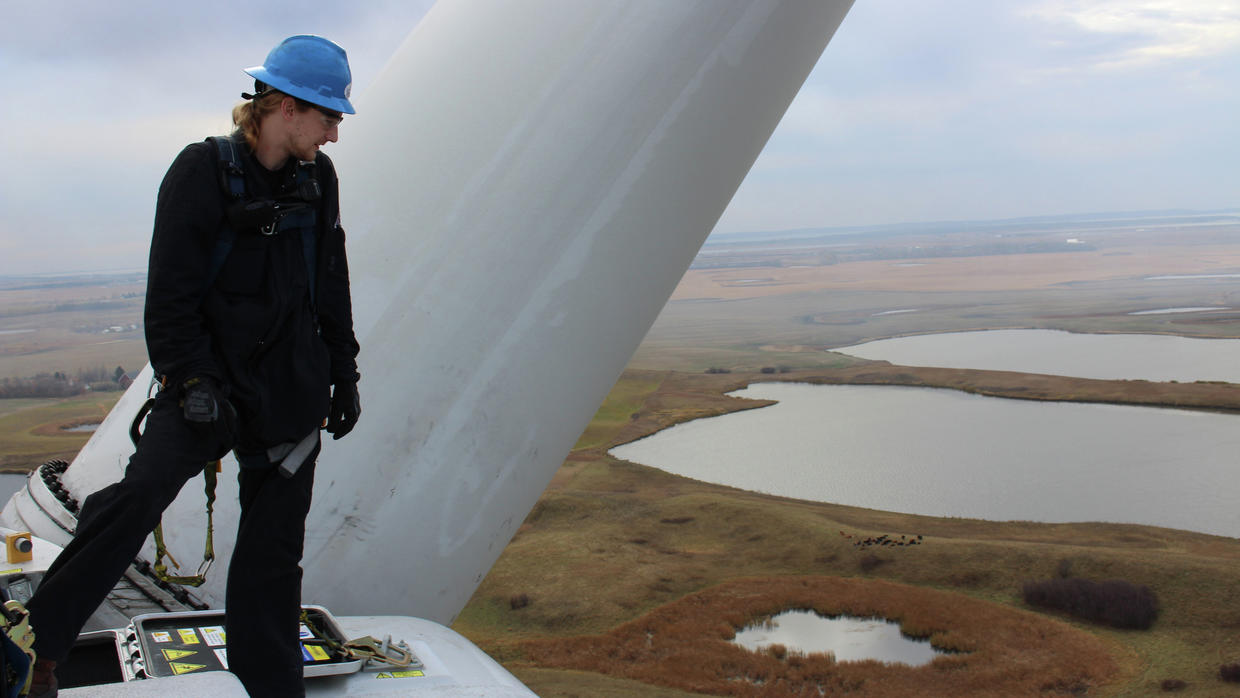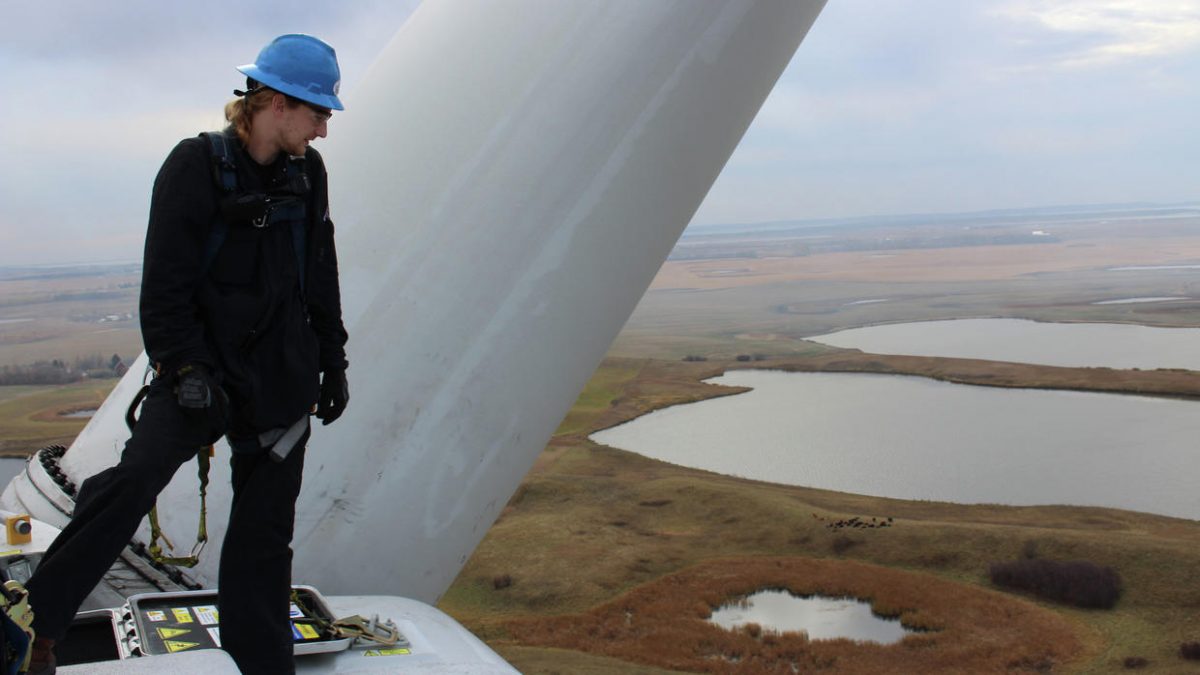
Renewable energy pays more than $7.7 million in property taxes in North Dakota, the study found.
Minnesota doesn’t produce fossil fuels, but has significant renewable energy resources. Renewable generation supplied about a quarter of Minnesota’s electricity in 2017.
North Dakota experiences nearly continuous winds, making it a sustainable source for wind energy. The U.S. Energy Information Administration (EIA) reported that average wind speeds in the state range from 10 to 13 mph.
The North Dakota Public Service Commission is also looking at approving the state’s first commercial-scale solar farm. The Public Service Commission had a hearing in the beginning of November for a solar farm near Casselton, N.D. Harmony Solar has proposed a 200-megawatt project. If approved, it will cost $320 million and would be completed in the next two years. And neighboring Minnesota has solar capacity of more than 700 megawatts, according to the Minnesota Department of Commerce.
“North Dakota is at the crossroads of energy,” said Jeff Deyette. “It is rich in fossil energy resources, but also rich in renewable energy resources.”
Deyette is the director of state policy and analysis for the Union of Concerned Scientists, a group of scientists that researches sustainability.
Coal is also still a heavy contributor to the state’s electricity generation, Deyette said. A quarter of the state’s energy comes from wind, yet more than 60 percent comes from coal.
Minnesota does not produce any coal. Most of the coal consumed in Minnesota comes from Wyoming and Montana. Almost 15 million tons of coal are transported from Montana and Wyoming each year, according to the EIA.
Five percent of the state’s energy comes from conventional hydropower, according to the EIA.
The Garrison Dam on the Missouri River is the only source of hydropower in North Dakota. Operating since 1955, it generates approximately 583 megawatts of energy.
“North Dakota is an interesting juxtaposition of where we hope to be heading, toward cleaner energy transition,” Deyette said.
Wind
Wind is by far the largest renewable in North Dakota, said Public Service Commissioner Randy Christmann. The PSC regulates public utilities.
North Dakota ranks fifth in the nation for its share of electricity generated from wind energy, according to the EIA.
Minnesota is also in the top 10 states for electricity generated from wind energy.
Wind power provides almost 20 percent of Minnesota’s total net energy generation, the EIA reported. Minnesota has many wind farms, totaling 3,699 megawatts of installed wind capacity.
Minnesota has invested more than $7 billion in wind energy, according to the American Wind Energy Association (AWEA). North Dakota has invested $5.8 billion in the wind industry.
Since May 2016, Christmann said, North Dakota has added over 1,000 megawatts of wind power. That brought the total megawatts of wind power in North Dakota to 3,000.
In the next year, 400 megawatts, which are currently under construction, will be completed.
The Public Service Commission is also considering three applications for approval that total 800 more megawatts. The commission hasn’t had hearings on those sites yet.
Brian Kroshus is also a public service commissioner. He said wind power is growing in North Dakota for four reasons.
The first is that the state has abundant wind resources, so it is an “attractive environment for wind developers to take advantage of,” Kroshus said.
Secondly, utility companies are being encouraged to switch to renewable energy because of subsidies in the state for wind and solar.
“There are very high subsidies for wind. People are pushing utility companies to use more non-carbon-producing energy sources,” Christmann said.
According the the EIA, the government subsidizes a wide variety of energy, from crude oil to wind. In 2016, the federal government subsidized $32.6 million for natural gas production, nearly $19 million for oil production and $2 million for wind energy production.
The third reason wind energy is growing in North Dakota, and many other states, is the renewable portfolio standards.
There are no statewide renewable energy goals in North Dakota, but in 2007, North Dakota set a voluntary target of having 10 percent of all retail electricity sold in the state be from renewable energy sources by 2015. In 2016, more than 21 percent of the electricity generated in North Dakota was from renewable energy.
Minnesota has mandatory renewable energy goals. The state wants 25 percent of its energy by 2025 to come from renewable energy resources. The renewable energy standards also require that 1.5 percent of all utilities’ retail electricity sales come from solar by 2020.
The standards also require that natural gas and electric utilities spend a percentage of their revenues on advancing energy efficiency and renewable energy, according to the EIA.
A fourth underlying factor is a social pressure to use “green energy,” Kroshus said.
“Younger demographics lean more towards renewables, and some companies like Amazon want to use renewables so that they can present that to their customer base,” Kroshus said.
Similar to the huge economic benefits to the state from the oil and gas boom, the abundance of wind resources in North Dakota also brings jobs and economic benefits.
“Wind brings in a lot of tax revenue to local areas,” Christmann said. “It is a good part of local tax payments, instead of coming to the state they go to the local county or school district.”
Wind farms also bring revenue to landowners with towers on their property. There are not a lot of long-term jobs, but a lot of short-term construction jobs in the wind power industry, Christmann said.
The benefits, according to AWEA, also are environmental.
The AWEA said that generating wind power creates no emissions and uses very little water. AWEA estimates that in 2017 5.2 million metric tons of carbon dioxide emissions were kept out of the atmosphere because of wind power.
Xcel Energy’s principal manager for the region, Mark Nisbet, said the he thinks wind has a solid return on investment. Xcel leases land from farmers, which in return, Nisbet said, pumps revenue into the local economy.
“We get to be involved a little bit in the communities when we start a project there,” Nisbet said.
Xcel has two wind farms in North Dakota, one under construction in Dickey County and the Glen Ullin 1 project in Morton and Mercer Counties. Xcel will purchase the energy this wind farm generates.
‘Too much?’
There are also negative impacts of wind, Christmann said.
“There are people who live nearby and don’t benefit,” he said. “They have to look at these huge turbines all day. They never have a dark night sky anymore because of the red flashing light on top of the turbine.”
Kroshus said the commission often hears from adjacent landowners, and their concern has been growing.
“When the first wind farms were placed in the state, they were viewed as a novelty, there were a lot of questions and curiosity surrounding them,” Kroshus said. “But … more and more of the North Dakota landscape is occupied by wind farms.”
People living near wind farms often complain of “shadow flicker,” which happens when a wind turbine is between a home and the sun.
“If you have a window pointed that way, you can get a burst of light every time the turbine spins, kind of like a strobe light,” Kroshus said.
There is also a conflict between wind farms and “agri-tourism,” Kroshus said.
“If someone has developed a ranch where you can come out and experience a day on the farm, they want an experience where you can see the rolling prairie for miles and miles and a campfire in the evening,” he said. “Blinking red lights may detract from that experience and impact their business.”
Kroshus said the commission hears more people expressing those concerns.
“Some people are concerned it is getting to be too much,” Kroshus said.
Replacing fossil fuels
Many worry that renewable energy is not a reliable source of energy.
But that is 20th century thinking, said Deyette.
“There have been great advances in technology, and renewable energy is more reliable and sustainable than ever,” Deyette said. “There’s not a lot of substance behind those concerns about the ability of renewable energy to provide power.”
While the wind does not blow all the time, Deyette said, the renewable energy industry has made huge strides in finding ways to store energy.
Renewable energy also is often paired with natural gas energy, which can act as a backup for wind or solar.
A lot of coal-generated electricity is coming off line across the country, Deyette said, and being replaced by natural gas plants.
In this region, OtterTail had a coal plant near Fergus Falls, Minn., which was recently replaced with wind and natural gas in North Dakota. Near Bismarck, Montana-Dakota Utilities replaced its coal-fired Heskett station with a natural-gas-fired plant, which was completed in 2015.
“Natural gas can be used as a technology that can help with fluctuations with other renewable energy resources,” Deyette said.
Renewable energies, such as wind, solar and natural gas, are becoming a more popular solution to powering American life. Oil will be replaced by natural gas as the No. 1 fuel source by 2024, Kroshus said. And renewable energy will continue to rise along the way.
“The United States is behind the times as a nation,” Kroshus said.

